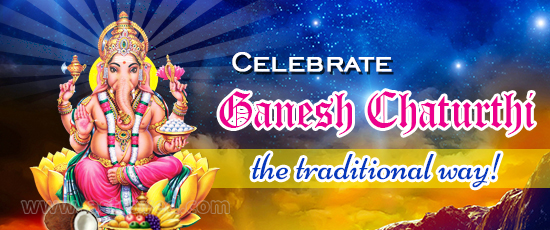Celebrate Ganesh Chaturthi the traditional way!
Ganesha or Vinayaka is the most popular God of the Hindus – he is worshipped across India by all sections of people. Being depicted in different postures such as dancing, reclining, playing musical instruments and so on shows how people love to see him as one amongst them…his presence boosts hope and the feel of prosperity.
The Hindu festival of Ganesh Chaturthi is celebrated with lot of joy as the birthday of Ganesha. According to Hindu calendar, it is the 4th day of waxing phase of Moon (shukla paksha) in the month of Bhadrapada. In many places like Maharashtra, Goa and Andhra Pradesh, the celebration continues till the 14th day (Ananta Chaturdasi) making it a 10 - day celebration.
Ganesha in Indian tradition:
In Hinduism, Ganesha is the ‘remover of obstacles’ and ‘giver of boons’. He is the God of good luck, prosperity and wisdom. He is the one who wrote down the epic Mahabharata related to him by sage Vyasa. If you take a walk down an Indian street, you will find him even in small neighborhood temples, painted or sculpted on the walls of houses, and business establishments. You will find him creatively designed on invitations cards for wedding, house-warming ceremonies and functions for new business ventures. His creatively made idols are popular items for gift.
Customs and rituals for celebrating Ganesh Chaturthi:
Creating the idol of Ganesha - Months before the celebration, clay idols of Ganesha are made especially for the occasion. They are adorned with bright colours, draped in shiny and glittering clothes, incarnating in different moods and postures. The idols are made of various sizes – usually the smaller varieties are for house-hold celebration and the ones that may reach 7 to 8 feet in height are placed on the pedestals or artificially made alters of the makeshift pandals. These temporary structures are creatively made to replicate different beautiful architectural structures sometimes after the famous monuments of India. Preparation for welcoming Ganesha – Amidst the excitement of welcoming Ganesha with pure joy and happiness, people get engaged in cleaning their houses and business spots, whitewashing with new paints, renovating and restoring. Business people start their new ledger book of accounts by offering it to the God. Installing Ganesha – The idol of Ganesha is installed on elaborately decorated altars. And he is established there amidst enthusiastic chant and call to the God for bringing prosperity. After installing him, begins the traditional ways of worshipping to invoke his presence – It is marked by devotional songs, mantras, offering of flowers, fire (arati) incense sticks, and so on. Representing Ganesha’s preferred circle (Mandal) – On a small raised platform, decorative patterns representing the Nine planets, the group of 16 goddesses, the symbol of Swastika and so on are created. These patterns are made with colored grains of rice, wheat and split green gram (moong) pulses. (This elaborate preparation is required if you wish to invoke the planets and all Goddesses after offering prayers to Ganesha.) In some cultures, just raw rice is spread on the platform. Then an iron or clay pot (kalash) with sacred water of Ganges or Kauvery River, is placed in the middle of the Mandal, topping it with a bunch of five betel or mango leaves and then an inverted coconut. Rolls of sacred white and red threads are placed on it. Three blade grass and leaves and flowers of Calotropis plant, commonly growing wayside flowering weeds, are offered. In case, a pot is difficult to arrange, a betel nut can be placed in its place along with coconut and other ingredients. The kalash or the betel-nut stands as the representative of the God on which tarpan ritual is practiced. Special items dear to Ganesha - Elaborate offerings of home-made dishes are offered to him. Afterall, Ganesha has a big belly to devour all that. Special sweets Modak made with jaggery and Motichur laddu are offered – they are his favorite! Ritual of Tarpan – This is a religious ritual of offering water to Gods while praying. Water is sprinkled on the kalash or betel-nut and the beej mantra ‘Gam/Gloum’ is chanted. This ritual is performed after all preparations for worship is complete and food items placed in front of Ganesha. Ritual of Arati - After tarpan, arati (lighting the cotton wicks soaked in butter) is performed to Ganesha chanting ‘Om Ganapati namaha/namaya’. The fire from arati lamp is waved in front of Ganesha with complete concentration on His presence. If you wish to make elaborate preparation for worshipping Ganesha, then you need to pray to him and then pray to the Nine planets and 16 Goddesses. Generally, Ganesha alone is worshipped. While performing these rituals we must not forget the essence of performing them – to concentrate and dwell in the consciousness of Ganesha and meditate on His attributes. Read our related articles Favorite Flowers of Lord Ganesha

Leave a Reply
Beena sudhakaran
Om gum ganapathaye namaha
August 22, 2018























